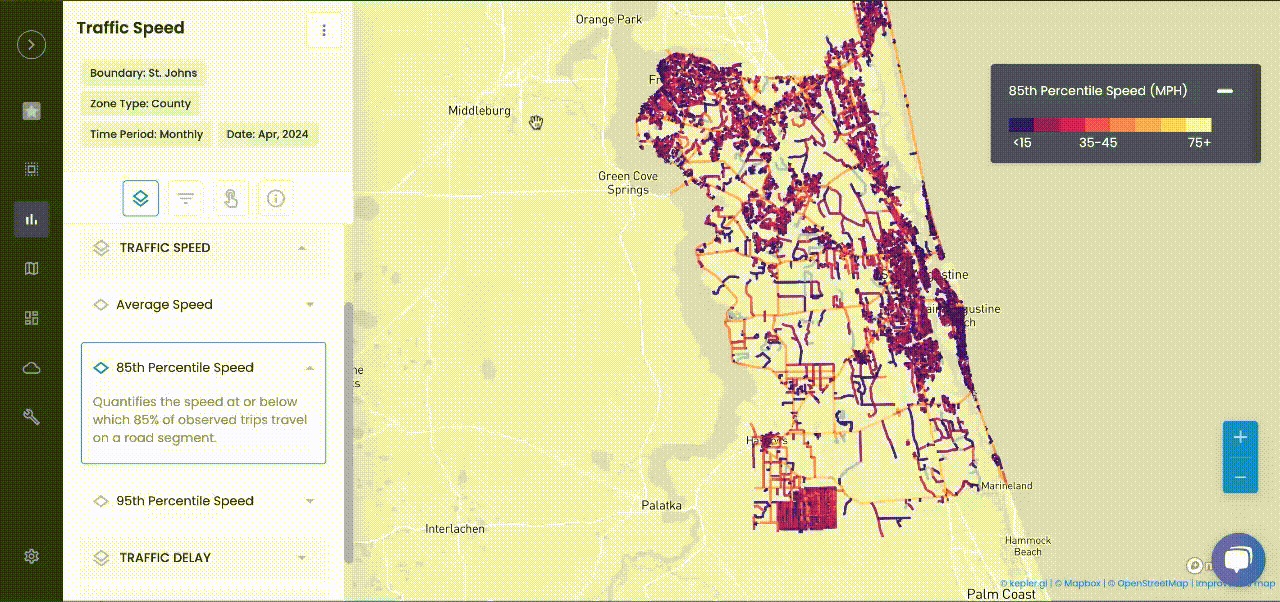
Traffic Volumes
Average Daily Traffic (ADT) vs. Annual Average Daily Traffic (AADT)
Understand the difference between Average Daily Traffic (ADT) and Annual Average Daily Traffic (AADT)
Understand the difference between Average Daily Traffic (ADT) and Annual Average Daily Traffic (AADT). Learn how Urban SDK helps agencies analyze both metrics.
When it comes to traffic data, two terms often create confusion: Average Daily Traffic (ADT) and Annual Average Daily Traffic (AADT). Both measure traffic volume as a daily average, but they represent very different timeframes. Knowing the distinction is essential for engineers, planners, and anyone interpreting traffic reports.
What is ADT?
Average Daily Traffic (ADT) is the average number of vehicles per day measured over a period shorter than one year. That period could be a few days, a month, or an entire season.
For example, if traffic counters recorded 140,000 vehicles in two weeks, the ADT for that period would be 10,000 vehicles per day. Because it only represents a slice of the year, ADT should always specify the timeframe, such as “July 2025 ADT = 12,000 vehicles/day.”
ADT is useful for:
- Seasonal traffic patterns (e.g., summer vs. winter volumes).
- Temporary traffic management, such as detours or construction closures.
- Capturing short-term studies when year-round data isn’t available.
What is AADT?
Annual Average Daily Traffic (AADT) represents the average daily traffic volume across an entire year. It accounts for weekdays, weekends, holidays, and seasonal fluctuations, providing a standardized number.
The formula is simple:
AADT = Total Yearly Traffic ÷ 365
For instance, if a road carried 3,650,000 vehicles in one year, the AADT would be 10,000 vehicles/day. Unlike ADT, AADT smooths out highs and lows to provide a consistent baseline.
AADT is the most commonly reported traffic metric in official databases and maps because it allows for:
- Year-over-year trend analysis.
- Comparisons between different locations.
- Planning, design, and funding decisions.
Key Differences Between ADT and AADT
ADT
Timeframe
Any period < 1 year (days, weeks, months, seasons)
Use Cases
Peak-season traffic, temporary closures, short-term analysis
Variability
Captures seasonal highs/lows
Official Reporting
Less common; used for specialized analysis
AADT
Timeframe
Full calendar year (365 days)
Use Cases
Capacity planning, official reporting, funding, long-term trends
Variability
Smooths fluctuations into one average
Official Reporting
Standard metric in traffic databases and reports
Why Both Metrics Matter
- ADT highlights conditions during peak demand. For example, a ski town might have an AADT of 5,000 but a winter ADT of 15,000, which is crucial for planning seasonal traffic management.
- AADT provides consistency for design standards, funding formulas, and comparisons. It is the “apples-to-apples” metric across roads and years.
Using both metrics together ensures planners design roads that function during everyday traffic while also accounting for seasonal surges.
Example Scenario
Imagine a coastal highway:
- Summer ADT: 20,000 vehicles/day
- Winter ADT: 5,000 vehicles/day
- Annual AADT: 10,000 vehicles/day
If planners relied only on the AADT, they might underestimate summer congestion. But if they looked only at the July ADT, they might overbuild infrastructure for a demand that’s seasonal. The right approach is to consider both metrics together.
Common Misunderstandings
- ADT is often used casually when AADT is meant. Always check the context.
- Official documents will specify AADT unless they are describing a specific period.
- AADT is the default assumption for published traffic counts unless labeled otherwise.
Final Thought
Think of AADT as climate (long-term average conditions) and ADT as weather (short-term fluctuations). Both are essential perspectives.
With Urban SDK’s Traffic Volume Data, agencies don’t have to wait for manual counts or static reports. Our platform delivers up-to-date AADT and ADT insights, helping planners manage long-term road capacity and short-term traffic surges alike.
Request a demo today to see how Urban SDK can turn raw traffic counts into smarter planning and safer roads.

TRAFFIC ENFORCEMENT FEATURES
80% of citizen complaints
are a perception problem
Urban SDK provides precise hourly speed data to evaluate complaints and deploy resources efficiently for the greatest impact to public safety.
Urban SDK provides precise hourly speed data to evaluate complaints and deploy resources efficiently for the greatest impact to public safety.
Target Speeding
Identify hot spots, validate monthly speeding trends and monitor vulnerable areas like school zones.
Improve Safety
Crash and citations location information to compare speed trends month over month
Fast Response
Respond to citizen complaints sooner with address search and exportable reporting
Deploy Assets
Generate maps for traffic enforcement by time of day, location or division to deploy officers to known problem areas.
RESOURCES
Customer Success
See how public sector leaders succeed with Urban SDK.
WEBINAR
Identify speeding and proactively enforce issues
See just how quick and easy it is to identify speeding, address complaints, and deploy officers.







